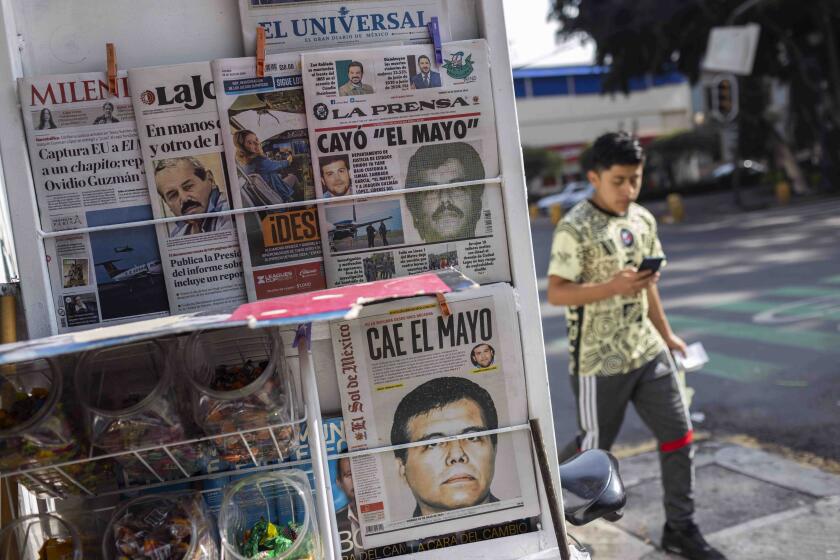Landslides buried at least 3 Indonesian villages, authorities say
Landslides triggered by last week’s massive earthquake wiped out three villages on the Indonesian island of Sumatra, killing at least 640 people, near Padang, the city closest to the epicenter, authorities said Saturday.
“The mud came off the hills and now there are almost no survivors,” said Zul Waddi, an official in Padang Pariaman, the district that encompasses the villages. “All I feel is sadness and pity.”
Waddi said many of the villagers probably had been celebrating after fasting during Ramadan.
The devastated communities are Paranan Bananak, Pulau Air and Lubuk Lawe, a cluster of villages about 35 miles from Padang, said Jufnedi, a police commissioner who uses only one name.
One resident who managed to escape said a stream of mud running from the collapsed hillside and into the river obliterated the villages.
Trees were uprooted, with bits of foliage sticking out of the mud, along with partly submerged roofs and wooden debris, said the resident, who asked not to be identified. A mosque was crushed, the minaret toppled.
Families and search crews, some clawing by hand through up to 30 feet of mud, struggled to find loved ones. Bodies were laid out in a nearby village, the resident said.
Right after the magnitude 7.6 quake hit Wednesday, most of the information the world received came from Padang, a city of 900,000. But with emergency workers fanning out to more remote areas Saturday, a wider picture of the damage began to emerge.
United Nations officials estimate that as many as 4,000 people are buried under rubble. More than three days after the disaster hit, the chances of pulling large numbers of them out alive are slim, experts said.
“The most critical need is to save lives of the people trapped under rubble. . . . Every minute is critical,” said Winston Chung, a member of the U.N. Disaster Assessment and Coordination team.
At the Ambacang Hotel in Padang, bulldozers and backhoes were used in the search for scores believed trapped in the collapsed building.
Betty Indah, 42, waited expectantly, as she had every day since the quake hit. Her husband was at the hotel Wednesday to speak at a business workshop. “I just want to know if he’s alive,” she said.
At the Foreign Language School of Prayoga, a Swiss evacuation team used a high-tech location device to search for six trapped students. After tearing furiously through the wreckage, emergency workers removed the students’ remains in bright yellow body bags.
The official quake death toll stood at 715, not including casualties in the buried villages. About 2,400 people have been hospitalized and tens of thousands are believed to be displaced. The government said more than 30,000 homes, schools, mosques, hospitals and offices had been flattened or badly damaged.
Disaster teams from the United States arrived in Padang on Saturday, joining the massive international aid and rescue operation. The home of the district governor was turned into a sprawling command center for humanitarian groups from around the world.
As more food and medical assistance arrive in Padang, teams of workers will focus on distributing aid to rural areas where the earthquake, aftershocks and landslides have devastated up to 80% of the structures, Chung said.
Tiziano Rosetto, head of University College London’s Earthquake and People Interaction Center, said preliminary evidence suggested that most of the concrete buildings in the area were not built to withstand earthquakes.
Although other factors may have contributed, she said, including corruption, lax building code enforcement and a weak inspection regime, it was evident that most supporting beams buckled rather than swayed. That meant they didn’t absorb much of the energy before collapsing outright, giving people little time to flee.
Poor construction techniques and low-quality materials probably contributed, she said. “Unfortunately this problem is quite common worldwide, not just in Indonesia or developing countries.”
A U.S. diplomatic team, meanwhile, continued its search for American tourists and expatriates in the area.
“We’ve checked all the locations that they might be and all the hospitals and morgues,” said Stanley Harsha, principal officer of the American Consulate in the northern Sumatran city of Medan. “We have found no dead or injured Americans.”
Members of a U.S. Disaster Assistance Response Team started arriving Friday to lend support in the rural areas after President Obama’s pledge to provide Indonesia with $3 million in aid.
“In the initial stage everyone is doing their own thing. It can be confusing [with] different countries bringing their own equipment and techniques,” said Al Dwyer, regional advisor for the U.S. Office of Foreign Disaster Assistance. “Coordination at this scale is an art rather than a science.”
--
McDermid is a special correspondent.
More to Read
Sign up for Essential California
The most important California stories and recommendations in your inbox every morning.
You may occasionally receive promotional content from the Los Angeles Times.










